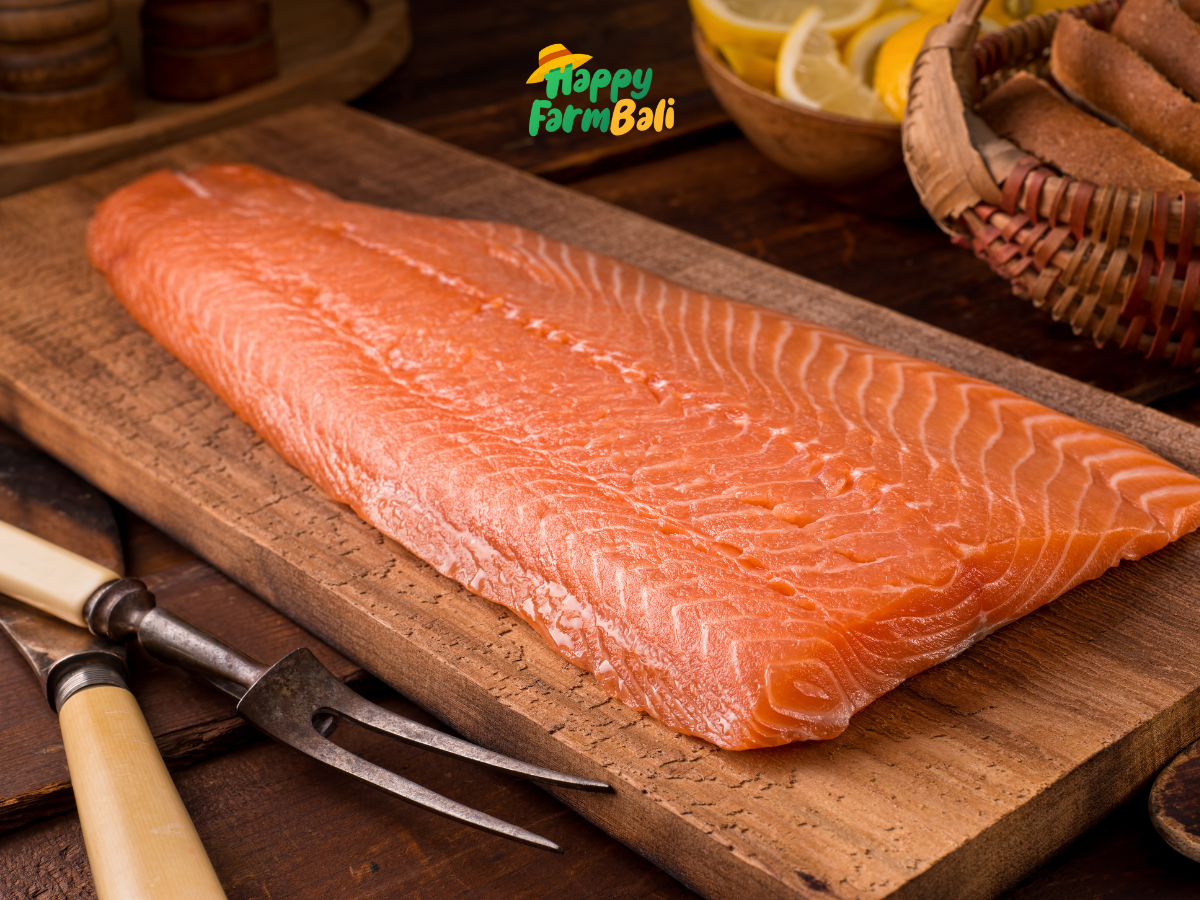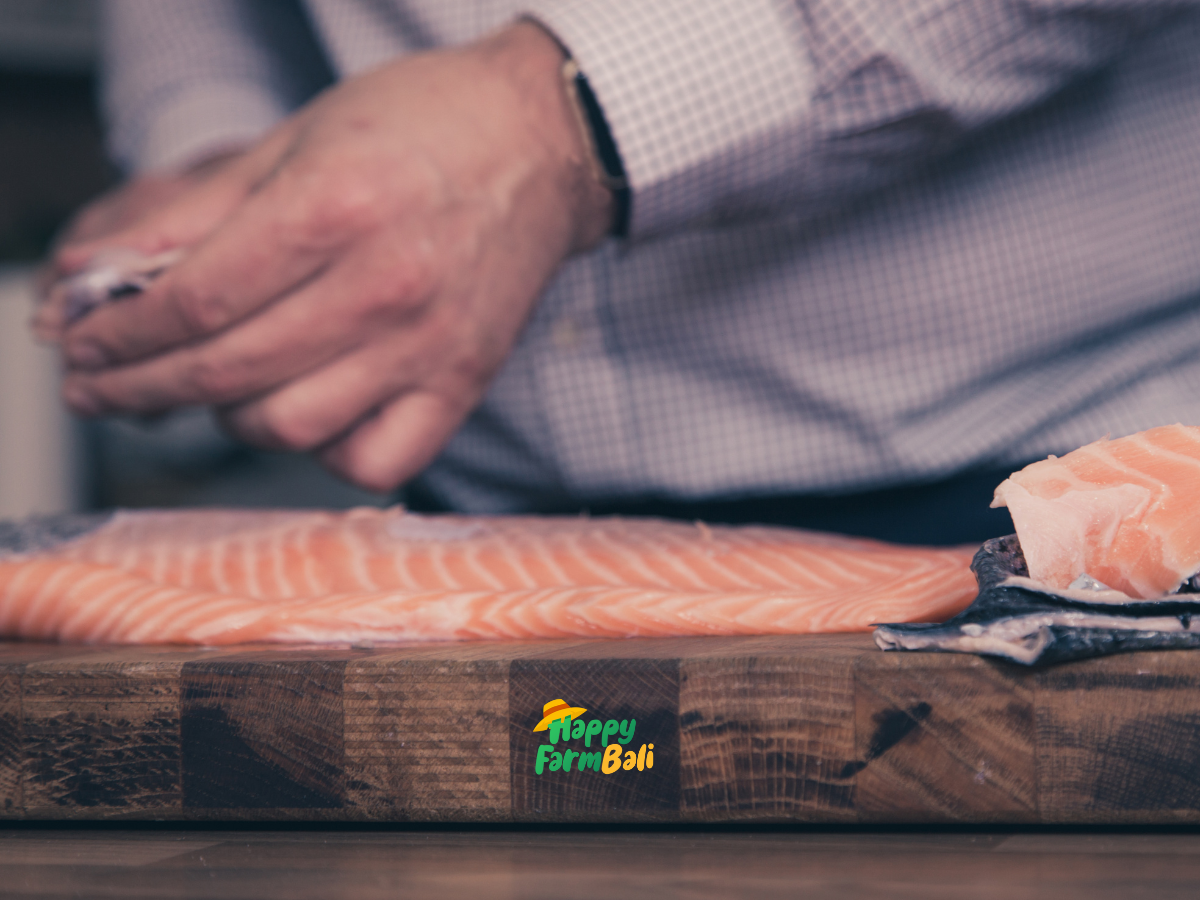Salmon Fillet
Salmon fillet obtained from the side of the fish, usually boneless and detached from the spine, is called fillet. The tender texture, distinctive flavor, and high nutrient content of salmon fillet are very popular. Freshness and quality are the main factors in choosing salmon fillet. The first thing to do is to clean the salmon. Next, cut it lengthwise along its spine to create two fillet pieces, which may or may not have skin. To ensure the fillet is free of bones, the small bones are then removed.
There are two basic types of fillet: fillet with skin, which enhances the flavor and helps the meat retain its shape when cooked, and fillet without skin, which are more suitable for some serving methods. You can buy these fillet fresh, which is easier to eat, or frozen, which makes them last longer. The advantage of salmon fillet is their high nutritional content. It has little saturated fat and a lot of protein. Additionally, it has omega-3 fatty acids, which are vital for the health of the heart and brain. Salmon fillet are also high in minerals including potassium, phosphorus, and selenium as well as vitamins B12 and D.
Due to the high concentration of vitamin D, salmon fillet provides several health benefits, such as reducing inflammation in the body, improving heart and brain health, and strengthening bones and teeth. To increase processing and serving flexibility, these salmon fillet can be prepared in a variety of ways, including grilled, seared, broiled, dipped, broiled, or served raw as sushi and sashimi. Many people prefer salmon fillet because they are nutrient-rich, easy to cook, and versatile enough to be used in a variety of delicious and healthy recipes.
Salmon Fillet Product
 First, let’s discuss what salmon is and how it came to be available in the market before talking about salmon fillet. Due to its high nutritional value and appetizing taste, salmon is one of the most sought-after fish species in the world. Omega-3 fatty acids, high-quality protein, vitamins, and minerals-all necessary for a healthy body are said to be abundant in salmon. Salmon is a versatile fish in terms of processing and presentation, whether served fresh, smoked or frozen.
First, let’s discuss what salmon is and how it came to be available in the market before talking about salmon fillet. Due to its high nutritional value and appetizing taste, salmon is one of the most sought-after fish species in the world. Omega-3 fatty acids, high-quality protein, vitamins, and minerals-all necessary for a healthy body are said to be abundant in salmon. Salmon is a versatile fish in terms of processing and presentation, whether served fresh, smoked or frozen.
This makes it a popular choice in home kitchens and restaurants. There are many processed salmon products available in the market, which makes it easier for consumers to enjoy this fish. Consumers can easily find and enjoy salmon in a variety of delicious and nutritious dishes thanks to the wide selection of salmon products available. The majority of salmon products often seen in sushi, sashimi and salmon steaks are boneless salmon. Salmon fillet are the most well-known salmon product, often the salmon found is trout salmon.
Salmon VS Trout
Many people have never met salmon’s close cousin: trout. Since they come from the same family, it is difficult but not impossible to distinguish the taste between salmon and trout. They actually look very similar with only a few key differences. First, salmon (saltwater fish) tend to be longer, smoother, and leaner, and their heads are more pointed and angular. In contrast, trout (freshwater fish) has a rounder head and more spots. Their textures are also very similar, with both considered to have a soft texture. However, trout has a slightly softer texture and is more delicious when eaten sashimi-style compared to salmon.
This fish is best cooked at medium rare to medium doneness to avoid being too dry due to its lesser fat content. Also, due to trout’s neutral flavor and lower fat content, it is able to absorb more spices and marinades making it a better blank canvas for marination. In addition to these visual differences, you can see the difference between salmon and trout in terms of texture and flavor. Salmon meat tends to contain more fat, giving it a richer and stronger flavor.
Meanwhile, trout is also known to be rich and delicious, although it has a milder and fresher flavor. As such, trout is perfect for those who still want to enjoy the experience of eating salmon, but without the overwhelming fishy flavor and aroma. When it comes to choosing fish, the difference between salmon and trout is clear, as both offer distinct flavors, diverse culinary possibilities, and abundant nutritional benefits. So, take a look at the world of seafood cuisine and let the salmon vs trout comparison be won over by individual tastes and flavors. Regardless of the choice of fish, salmon or trout, both provide plenty of nutritional benefits (protein, vitamins, and minerals), and satisfy your palate.
Nutrient Content of Salmon Trout
 Salmon trout, a versatile and readily available fish, contains heart-healthy omega-3s, high-quality protein, and is rich in micronutrients. Those interested in trout salmon nutrition facts should know that higher omega-3 intake is associated with a reduced risk of certain diseases such as cardiovascular disease, Alzheimer’s disease, and other conditions.
Salmon trout, a versatile and readily available fish, contains heart-healthy omega-3s, high-quality protein, and is rich in micronutrients. Those interested in trout salmon nutrition facts should know that higher omega-3 intake is associated with a reduced risk of certain diseases such as cardiovascular disease, Alzheimer’s disease, and other conditions.
Despite concerns about mercury and other contaminants in fish, salmon is rich in nutrients with minimal toxins, regardless of whether buying farmed or wild-caught fish. Here’s a breakdown of the nutritional content in the meat of this popular fish:
Carbohydrates
Salmon is naturally carbohydrate-free, including fiber and sugar.
Fat
3 ounces of raw salmon contains 5.4 grams of fat. Of this, about 1.5 grams comes from beneficial omega-3 fatty acids, including EPA and DHA. Less than 1 gram comes from saturated fat.
The fatty acid composition of salmon varies depending on whether the salmon is farmed or wild-caught. Farmed salmon has a higher fat content, including saturated fat, while wild salmon has a lower fat content.
Protein
There are 17 grams of protein in 3 ounces of raw wild-caught salmon. Since farm-raised salmon has more fat, it contains slightly less protein. Nonetheless, salmon is a high-quality source of protein that provides all the essential amino acids our bodies need.
Vitamins and Minerals
Salmon contains vitamin A and vitamin B complexes. Salmon is one of the few natural foods that contain vitamin D (wild salmon is the best source). Several minerals, such as zinc, selenium, magnesium, potassium, phosphorus and zinc, can be found in salmon. In addition, canned salmon contains a lot of calcium (as the bones are edible).
Calories
Salmon has 121 calories per three ounces, the majority of which are derived from protein. Some calories also come from healthy fats.
Salmon Fillet Supplier in Bali
 Salmon fillet supplier play an important role in the salmon supply chain and distribution to businesses such as hotels and restaurants. In general, salmon fillet suppliers play a crucial role in the procurement cycle by ensuring that hotels and restaurants receive timely, high-quality and fresh products, comply with all applicable laws and regulations, and uphold good customer relations. For companies in the culinary field, Happy Farm Bali is highly recommended as the best salmon fillet supplier.
Salmon fillet supplier play an important role in the salmon supply chain and distribution to businesses such as hotels and restaurants. In general, salmon fillet suppliers play a crucial role in the procurement cycle by ensuring that hotels and restaurants receive timely, high-quality and fresh products, comply with all applicable laws and regulations, and uphold good customer relations. For companies in the culinary field, Happy Farm Bali is highly recommended as the best salmon fillet supplier.
Happy Farm Bali ensures that its customers get the best product by selecting salmon according to high quality standards. An important stage in ensuring high quality products is the careful monitoring of the cleanliness and freshness of the fish during the selection process. The commitment to product freshness and quality is unquestionable. As a salmon fillet supplier, Happy Farm Bali uses a quick freezing method to preserve the flavor, texture, and nutritional content of the salmon.
Happy Farm also provides a wide range of salmon products, from frozen salmon to fillet. Choosing Happy Farm Bali as your salmon fillet supplier will ensure consistent availability, reliable logistics services, and high quality products throughout the day. This will ensure customer satisfaction and enhance the reputation of your company (including hotels and restaurants).
